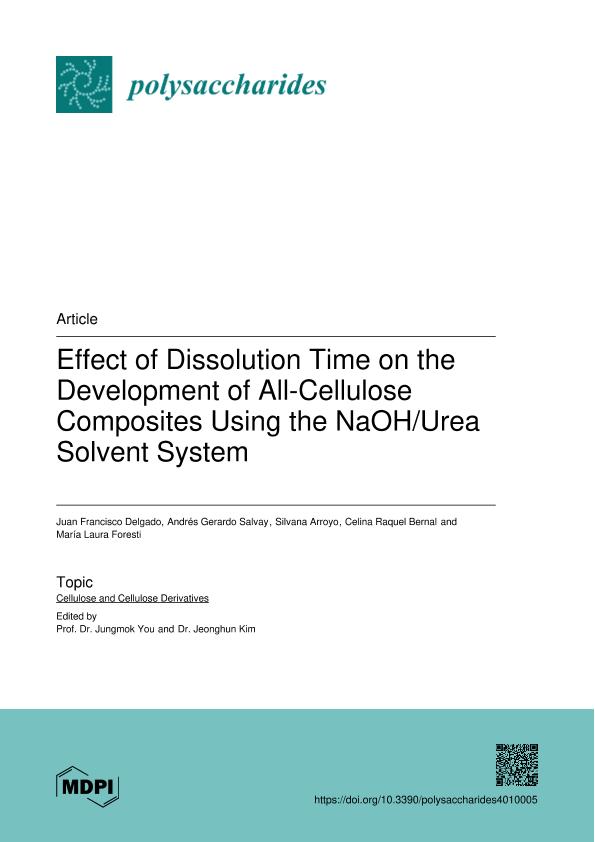Artículo
Effect of Dissolution Time on the Development of All-Cellulose Composites Using the NaOH/Urea Solvent System
Delgado, Juan Francisco ; Salvay, Andrés Gerardo; Arroyo, Silvana Maricel
; Salvay, Andrés Gerardo; Arroyo, Silvana Maricel ; Bernal, Celina Raquel
; Bernal, Celina Raquel ; Foresti, María Laura
; Foresti, María Laura
 ; Salvay, Andrés Gerardo; Arroyo, Silvana Maricel
; Salvay, Andrés Gerardo; Arroyo, Silvana Maricel ; Bernal, Celina Raquel
; Bernal, Celina Raquel ; Foresti, María Laura
; Foresti, María Laura
Fecha de publicación:
02/2023
Editorial:
MDPI
Revista:
Polysaccharides
ISSN:
2673-4176
Idioma:
Inglés
Tipo de recurso:
Artículo publicado
Clasificación temática:
Resumen
Innovative and sustainable all-cellulose composites (ACCs) can be obtained by partial dissolution of cellulosic fibers and regeneration of the dissolved fraction. Among cellulose solvents, sodium hydroxide/urea solutions are recognized as promising low-environmental impact systems. In this work, filter paper (FP) was dissolved with a 7 wt% NaOH/12 wt% urea aqueous solution, kept at −18 °C for different time intervals, regenerated with distilled water and finally dried under different conditions. The developed films were characterized in terms of morphology, porosity, optical properties, crystalline structure, hydration and mechanical properties. The porosity of the composites decreased with dissolution time due to the progressive filling of voids as the cellulosic fibers’ surface skin layer was dissolved and regenerated. Samples treated for 4 h showed the minimum values of porosity and opacity, high hydration and a substantial change from cellulose I to cellulose II. Hot pressing during drying led to relevant improvements in ACCs stiffness and strength values.
Archivos asociados
Licencia
Identificadores
Colecciones
Articulos(INTECIN)
Articulos de INST.D/TEC.Y CS.DE LA ING."HILARIO FERNANDEZ LONG"
Articulos de INST.D/TEC.Y CS.DE LA ING."HILARIO FERNANDEZ LONG"
Articulos(ITPN)
Articulos de INSTITUTO DE TECNOLOGIA EN POLIMEROS Y NANOTECNOLOGIA
Articulos de INSTITUTO DE TECNOLOGIA EN POLIMEROS Y NANOTECNOLOGIA
Citación
Delgado, Juan Francisco; Salvay, Andrés Gerardo; Arroyo, Silvana Maricel; Bernal, Celina Raquel; Foresti, María Laura; Effect of Dissolution Time on the Development of All-Cellulose Composites Using the NaOH/Urea Solvent System; MDPI; Polysaccharides; 4; 1; 2-2023; 65-77
Compartir
Altmétricas



